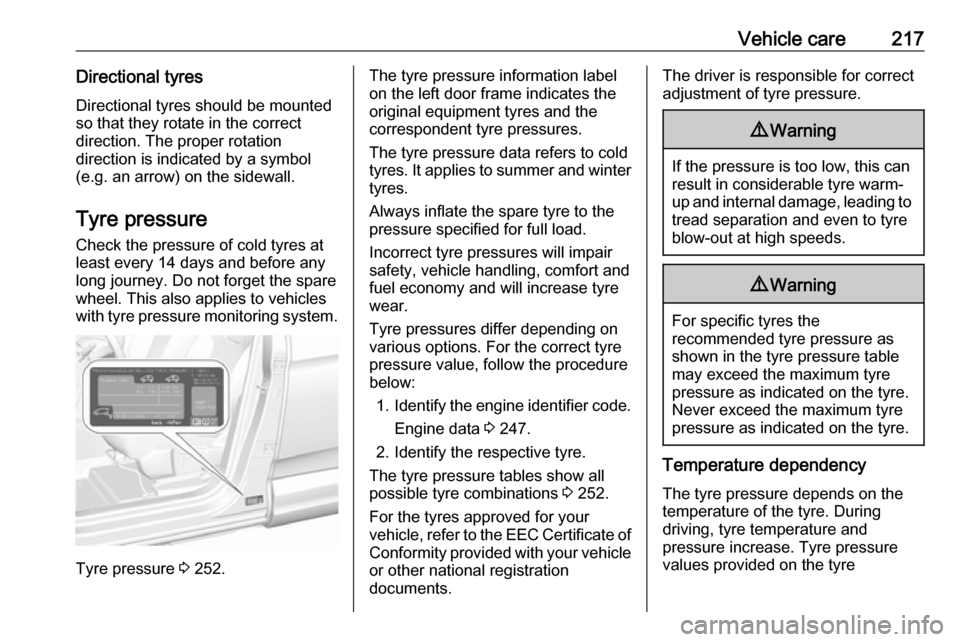2019.75 VAUXHALL GRANDLAND X fuel pressure
[x] Cancel search: fuel pressurePage 79 of 271

Storage77To calculate the payload, enter
the data for your vehicle in the
weights table at the front of this
manual.
The EC kerb weight includes
weights for the driver (68 kg),
luggage (7 kg) and all fluids (fuel
tank 90% full).
Optional equipment and
accessories increase the kerb
weight.
● Driving with a roof load increases
the sensitivity of the vehicle to
cross-winds and has a
detrimental effect on vehicle
handling due to the vehicle's
higher centre of gravity.
Distribute the load evenly and secure it properly with retaining
straps. Adjust the tyre pressure
and vehicle speed according to
the load conditions. Check and
retighten the straps frequently.
Do not drive faster than 75 mph.
The permissible roof load is
85 kg. The roof load is the
combined weight of the roof rack and the load.
Page 80 of 271

78Instruments and controlsInstruments and
controlsControls ....................................... 79
Steering wheel adjustment ........79
Steering wheel controls .............79
Heated steering wheel ...............79
Horn ........................................... 80
Windscreen wiper and washer ..80
Rear window wiper and washer ...................................... 82
Outside temperature ..................82
Clock ......................................... 83
Power outlets ............................. 84
Inductive charging .....................86
Cigarette lighter ......................... 86
Ashtrays .................................... 87
Warning lights, gauges and indi‐ cators ........................................... 87
Instrument cluster ......................87
Speedometer ............................. 88
Odometer .................................. 88
Trip odometer ............................ 88
Tachometer ............................... 89
Fuel gauge ................................ 89
Engine coolant temperature gauge ....................................... 89Engine oil level monitor.............90
Service display .......................... 90
Control indicators ......................91
Turn lights .................................. 91
Seat belt reminder .....................91
Airbag and belt tensioners .........92
Airbag deactivation ....................92
Charging system .......................92
Malfunction indicator light ..........92
Service vehicle soon .................93
Stop engine ............................... 93
System check ............................ 93
Brake and clutch system ...........93
Electric parking brake ................93
Electric parking brake fault ........94
Antilock brake system (ABS) .....94
Gear shifting .............................. 94
Lane departure warning ............94
Lane keep assist .......................94
Electronic Stability Control and Traction Control system ...........95
Engine coolant temperature ......95
Preheating ................................. 95
Exhaust filter .............................. 95
AdBlue ....................................... 95
Deflation detection system ........96
Engine oil pressure ....................96
Low fuel ..................................... 96
Autostop .................................... 96
Exterior light .............................. 96Low beam.................................. 97
High beam ................................. 97
High beam assist .......................97
LED headlights .......................... 97
Front fog lights ........................... 97
Rear fog light ............................. 97
Rain sensor ............................... 97
Cruise control ............................ 97
Adaptive cruise control ..............97
Vehicle detected ahead .............97
Side blind spot alert ...................97
Active emergency braking .........98
Speed limiter ............................. 98
Door open .................................. 98
Displays ....................................... 98
Driver Information Centre ..........98
Info Display .............................. 100
Vehicle messages ......................102
Warning chimes .......................102
Vehicle personalisation ..............103
Telematics services ...................106
Vauxhall Connect ....................106
Page 90 of 271

88Instruments and controlsW oEngine coolant temperature
high 3 95!Preheating 3 95%Exhaust filter 3 95YAdBlue 3 95wDeflation detection system
3 96IEngine oil pressure 3 96Y oLow fuel 3 96DAutostop 3 968Exterior light 3 969Low beam 3 97CHigh beam 3 97fHigh beam assist 3 97>Front fog lights 3 97øRear fog light 3 97
Speedometer
Indicates vehicle speed.
Odometer
The total recorded distance is
displayed in miles.
Driver Information Centre
Trip odometer
Page 98 of 271

96Instruments and controlsAdBlue level is low. Refill AdBlue
soon to avoid prevention of the
engine start. Up to 10 l of AdBlue can
be added.
AdBlue 3 138.
Deflation detection system
w illuminates or flashes yellow.
Illuminates
Tyre pressure loss in one or more
wheels. Stop immediately and check
tyre pressure.
Flashes Fault in system. Consult a workshop.
Deflation detection system 3 218.
Engine oil pressure I illuminates red.
Illuminates when the ignition is
switched on and extinguishes shortly
after the engine starts.Illuminates when the engine is
runningCaution
Engine lubrication may be
interrupted. This may result in
damage to the engine and / or
locking of the drive wheels.
1. Select neutral gear.
2. Move out of the flow of traffic as quickly as possible without
impeding other vehicles.
3. Switch off ignition.
9 Warning
When the engine is off,
considerably more force is needed
to brake and steer. During an
Autostop the brake servo unit will still be operational.
Do not remove key until vehicle is stationary, otherwise the steering
wheel lock could engage
unexpectedly.
Keep engine turned off and let the
vehicle be towed to a workshop.
Low fuel o illuminates yellow.
Level in fuel tank is too low.
Refuelling 3 189.
Bleeding the diesel fuel system
3 204.
Autostop D illuminates or flashes green.
Illuminates green
Engine is in an Autostop.
Flashes green
Autostop is temporarily unavailable,
or Autostop mode is invoked
automatically.
Stop-start system 3 134.
Exterior light 8 illuminates green.
The exterior lights are on 3 108.
Page 198 of 271

196Vehicle careVehicle careGeneral Information...................196
Accessories and vehicle modifications .......................... 196
Vehicle storage ........................198
End-of-life vehicle recovery .....198
Vehicle checks ........................... 199
Performing work ......................199
Bonnet ..................................... 199
Engine oil ................................. 200
Engine coolant ......................... 201
Washer fluid ............................ 201
Brakes ..................................... 202
Brake fluid ............................... 202
Vehicle battery ......................... 202
Diesel fuel system bleeding .....204
Wiper blade replacement ........204
Bulb replacement .......................205
Halogen headlights ..................205
LED headlights ........................ 207
Front fog lights ......................... 207
Tail lights ................................. 207
Side turn lights ......................... 210
Number plate light ...................211
Interior lights ............................ 211Electrical system........................211
Fuses ....................................... 211
Engine compartment fuse box . 212
Instrument panel fuse box .......213
Vehicle tools .............................. 215
Tools ........................................ 215
Wheels and tyres .......................216
Winter tyres ............................. 216
Tyre designations ....................216
Tyre pressure .......................... 217
Tyre deflation detection system .................................... 218
Tread depth ............................. 219
Changing tyre and wheel size . 219
Wheel covers ........................... 220
Tyre chains .............................. 220
Tyre repair kit .......................... 220
Wheel changing .......................223
Spare wheel ............................ 225
Jump starting ............................. 228
Towing ....................................... 230
Towing the vehicle ...................230
Towing another vehicle ...........231
Appearance care .......................232
Exterior care ............................ 232
Interior care ............................. 234
Floor mats ............................... 234General Information
Accessories and vehicle modifications
We recommend the use of genuine parts and accessories and factory
approved parts specific for your
vehicle type. We cannot assess or
guarantee reliability of other products - even if they have a regulatory or
otherwise granted approval.
Any modification, conversion or other
changes made to standard vehicle
specifications (including, without
limitation, software modifications,
modifications of the electronic control units) may invalidate the warranty
offered by Vauxhall. Furthermore,
such changes may affect driver
assistance systems, may impact fuel
consumption, CO 2 emissions and
other emissions of the vehicle and
cause the vehicle to no longer
conform to the operating permit,
impacting the validity of your vehicle
registration.
Page 200 of 271

198Vehicle careVehicle storageStorage for a long period of timeIf the vehicle is to be stored for several months:
● Wash and wax the vehicle.
● Have the wax in the engine compartment and underbody
checked.
● Clean and preserve the rubber seals.
● Fill up fuel tank completely.
● Change the engine oil.
● Drain the washer fluid reservoir. ● Check the coolant antifreeze and
corrosion protection.
● Adjust tyre pressure to the value specified for full load.
● Park the vehicle in a dry, well ventilated place. Engage first or
reverse gear or set selector lever
to P. Prevent the vehicle from
rolling.
● Do not apply the parking brake.● Open the bonnet, close all doors and lock the vehicle.
● Disconnect the clamp from the negative terminal of the vehicle
battery. Note that all systems are
not functional, e.g. anti-theft
alarm system.
Putting back into operation When the vehicle is to be put back into
operation:
● Connect the clamp to the negative terminal of the vehicle
battery. Initialize the power
windows 3 39.
● Check tyre pressure.
● Fill up the washer fluid reservoir.
● Check the engine oil level.
● Check the coolant level.
● Fit the number plate if necessary.End-of-life vehicle recovery
Information on end-of-life vehicle
recovery centres and the recycling of
end-of-life vehicles is available on our website, where legally required. Only
entrust this work to an authorised
recycling centre.
Page 219 of 271

Vehicle care217Directional tyresDirectional tyres should be mounted
so that they rotate in the correct
direction. The proper rotation
direction is indicated by a symbol (e.g. an arrow) on the sidewall.
Tyre pressure
Check the pressure of cold tyres at
least every 14 days and before any
long journey. Do not forget the spare
wheel. This also applies to vehicles
with tyre pressure monitoring system.
Tyre pressure 3 252.
The tyre pressure information label
on the left door frame indicates the
original equipment tyres and the
correspondent tyre pressures.
The tyre pressure data refers to cold
tyres. It applies to summer and winter tyres.
Always inflate the spare tyre to the
pressure specified for full load.
Incorrect tyre pressures will impair
safety, vehicle handling, comfort and
fuel economy and will increase tyre
wear.
Tyre pressures differ depending on
various options. For the correct tyre
pressure value, follow the procedure
below:
1. Identify the engine identifier code.
Engine data 3 247.
2. Identify the respective tyre.
The tyre pressure tables show all
possible tyre combinations 3 252.
For the tyres approved for your
vehicle, refer to the EEC Certificate of Conformity provided with your vehicle
or other national registration
documents.The driver is responsible for correct adjustment of tyre pressure.9 Warning
If the pressure is too low, this can
result in considerable tyre warm-
up and internal damage, leading to tread separation and even to tyre
blow-out at high speeds.
9 Warning
For specific tyres the
recommended tyre pressure as
shown in the tyre pressure table may exceed the maximum tyre
pressure as indicated on the tyre.
Never exceed the maximum tyre
pressure as indicated on the tyre.
Temperature dependency
The tyre pressure depends on the
temperature of the tyre. During
driving, tyre temperature and
pressure increase. Tyre pressure
values provided on the tyre
Page 235 of 271

Vehicle care233Plastic body parts must not be treated
with wax or polishing agents.
Windows and wiper blades
Switch off wipers before handling in
their areas.
Use a soft lint-free cloth or chamois leather together with window cleaner and insect remover.
When cleaning the rear window from
inside, always wipe in parallel to the
heating element to prevent damage.
For mechanical removal of ice, use a
sharp-edged ice scraper. Press the
scraper firmly against the glass so
that no dirt can get under it and
scratch the glass.
Clean smearing wiper blades with a
soft cloth and window cleaner.
Remove dirt residues from smearing
wiper blades by using a soft cloth and window cleaner. Also make sure to
remove any residues such as wax,
insect residues and similar from the
window.
Ice residues, pollution and continuous
wiping on dry windows will damage or
even destroy the wiper blades.Glass panel
Never clean with solvents or abrasive
agents, fuels, aggressive media e.g.
paint cleaner, acetone-containing
solutions, acidic or highly alkaline
media or abrasive pads.
Wheels and tyres Do not use high-pressure jet
cleaners.
Clean rims with a pH-neutral wheel
cleaner.
Rims are painted and can be treated
with the same agents as the body.
Paintwork damage Rectify minor paintwork damage with
a touch-up pen before rust forms.
Have more extensive damage or rust areas repaired by a workshop.
Underbody
Some areas of the vehicle underbody
have a PVC undercoating while other critical areas have a durable
protective wax coating.After the underbody is washed, check
the underbody and have it waxed if
necessary.
Bitumen / rubber materials could
damage the PVC coating. Have
underbody work carried out by a
workshop.
Before and after winter, wash the
underbody and have the protective
wax coating checked.
Liquid gas system9 Danger
Liquid gas is heavier than air and
can collect in sink points.
Take care when performing work
at the underbody in a pit.
For painting work and when using a
drying booth at a temperature above
60 °C, the liquid gas tank must be
removed.
Do not make any modifications to the
liquid gas system.